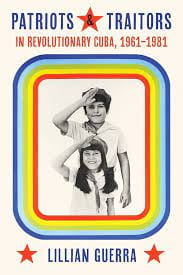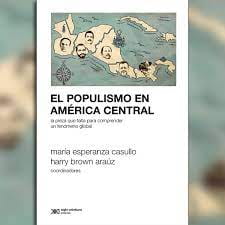A Review of Patriots and Traitors in Revolutionary Cuba, 1961-1981
I remember when I first heard Lillian Guerra speak: over fifteen years ago, at Brown University, about her third book, Visions of Power in Cuba: Revolution, Redemption and Resistance (1959-1971). The book is a revelation and the lecture was dazzling. What stays with me most, though, is the moment of silence that followed the lecture, and how Guerra, rather than sit out the awkwardness, broke it with an animated “Well, what do you think? I’m really excited about this! I want your questions!” It was clear then as now that her scholarship is not only brilliant but also a passion, a conversation and a collaboration.
Guerra’s latest book, Patriots and Traitors in Revolutionary Cuba, 1961-1981, is a tour de force. Like her four previous books, it is powered by a full command of Cuba’s official history and the copious scholarship it has spurred; extensive research in public archives spread far and wide; and intimacy with the private archives of Cubans who have carried deep pain for decades, shared through what must have been a careful process of building trust. Guerra expertly weaves a vast array of materials into a coherent, commanding story about the insidious operations of the Cuban state that, at the same time, tells the varied and silenced stories of people who took a quiet stand against it.

Patriots and Traitors in Revolutionary Cuba, 1961-1981 by Lillian Guerra (University of Pittsburgh Press, 2023, 508 pages)
The book shows how the categories of “revolutionary” and “counterrevolutionary” were crafted covertly and highly effectively between 1961 and 1981, two long decades whose role in shaping and reshaping the state’s hold on its citizens has, as Guerra notes, been far less studied that than the first two frenetic, spectacular years that followed Fidel Castro’s seizure of power in 1959. These two decades saw the systematic implementation of what Guerra terms a “total state,” one that “claimed the right to infuse citizens’ consciousness with a commitment to ‘the Revolution’ before self, family, friends, dreams or desires” (25). Cubans who chose to stay, rather than leave, publicly gave their lives to this total state, even as they saw its practices diverge from their expectations and understandings of revolution. Thus, Guerra claims, Cuba became a society “of patriots and traitors, not patriots or traitors, because most Cubans lived withing the binary, not exclusively on either side of it” (9).
One of the book’s most striking arguments is that the Cuban Revolution not only demanded its citizens’ full political commitment, but also co-opted, redefined and instrumentalized their emotions. Indeed, at one level, Patriots and Traitors reads as a history of emotion in post-1959 Cuba. Love is a primary emotion here: instilled from the literacy campaign of 1961 on, an active, demonstrative and binding love for the Revolution was to supersede intimacy in any other domain. Fear, too, was central to the Revolution’s emotional toolkit, with the normalization of executions and mass denunciations of those deemed traitors underpinned by the ubiquitous but extremely secret state security apparatus of the 1960s—which became much more visible in the 1970s, when security personnel stood as “evaluators of culture and curators of meaning” (288). Generosity is cast as a motor of the Revolution’s programs to rehabilitate ideological dissenters and reeducate those who lingered in labor inequality—and Guerra records the frustration and incredulity of educators as women in domestic service remained close to their employers, and prostitutes refused to renounce their lucrative but unrevolutionary work. “Vergüenza,” Guerra demonstrates, is a more complex entry in the Revolution’s emotional lexicon: translating literally as “shame,” it was shaped as a politically beneficial emotion in Cuba, connoting pride, self-sacrifice and humility.
Guerra is a vivid, empathic storyteller, and the wealth of personal interviews she draws on add a very human dimension to the book. One of the most poignant is with Teresita Suárez Tous, the widow of a former Revolutionary fighter and once celebrated hero who, in the early 1960s, fell afoul of Fidel Castro for his opposition to, among other features of the new political landscape, executions, communism and anti-constitutionalism. Teresita’s husband was killed by firing squad in 1961, when she was 21 years old, newly married and caring for a baby daughter. The detailed account of her tragedy is chilling: her realization that, despite the lack of evidence against him, her husband would be executed; her visits to him in prison, baby in tow; her conversations with priests and guards at the prison; and her encounter with gleeful schoolchildren recruited as spectators for the execution. The account includes two of Teresita’s wedding photographs, and I can only imagine the register of private emotions—counter to those publicly scripted by the Revolution—with which this now elderly woman shared these and her story with Guerra, for publication.
Guerra shows that while in the early 1960s the Revolution’s so-called “traitors” were often those—like Teresita Suárez Tous’ husband—who had been instrumental in bringing it to power, the label later extended far more deeply into Cuban society. Particularly vulnerable to its vagaries were Cuba’s writers, artists and intellectuals, and the book casts new light on many figures who hovered precariously at the patriot-traitor binary over the years. The fate of the poet Heberto Padilla—in 1971, arrested, imprisoned and forced to publicly confess and denounce his own and others’ counterrevolutionary tendencies—has been the best documented of such cases, particularly with the release in 2022 of Pavel Giroud’s documentary El Caso Padilla. Guerra’s meticulous research shows how other lives, around Padilla’s, were positioned often painfully in relation to this binary: the aristocratic poet Dulce María Loynaz, isolated in her mansion in Havana but an active participant in seminars with Catholic priests; the singer-songwriter Silvio Rodríguez, punished for ideological diversion and subsequently rehabilitated but writing unrecordable songs that registered his disillusion; the filmmaker Sara Gómez, whose uncompromising De cierta manera was revised and released in a smoothed-out version after her death in 1974. More figures may have been added to this roster – I note the absence of Reinaldo Arenas, whose testimony of leaving in the Mariel exodus of 1980 resonates closely with those quoted in the chapter on this episode – but these are exemplary stories of intellectuals who wrestled with the patriot-traitor binary for most of their adult lives.
While Cubans have born the full brunt of the Revolution’s suspicions and conscriptions, non-Cubans have also fallen within their orbit. Many scholars have noted that visitors to Cuba see a curated version of Revolutionary prowess, be this in the early 1960s—when luminaries like Jean-Paul Sartre and Simone de Beauvoir were guests of Fidel Castro—or in much later decades, when the island’s economy became increasingly dependent on tourism. Guerra unearths the intricacies of this rigid showcasing, particularly in the 1970s as the Sovietization of institutions solidified.
As interesting, though are the lesser-known complicities and discomforts of the many non-Cubans who chose to live in, rather than merely visit, Cuba, in some cases renouncing their original citizenship in order to embrace the Revolution. A harsh portrayal emerges of the U.S. writer Margaret Randall, resident in Cuba for twelve years and a beneficiary of much largesse, even as she tangled breezily with more earnest critics like Sara Gómez and invented ever more elaborate justifications for the contradictions around her. The East German educator Monika Krause cuts a more sympathetic figure, her hesitations increasingly manifest in her memoir; while former Black Panther Bill Brent, a refugee in Cuba from 1969 until his death in 2016, encounters a much less polished version of the Revolution and levels pointed critiques.
The experiences of the children of non-Cuban devotees of the Revolution have a particular role in Guerra’s account: Margaret Randall’s son Gregory, who spent his childhood in Cuba and whose memoir shows him to be both participant in and observer of the Revolution; Dictys, the son of Monika Krause and a captain in the Cuban intelligence force, whose experience at “La Lenin,” the vocational school that was the crown jewel in the educational system and “the first elite school in Cuba’s twentieth-century history to epitomize the values of racial integration and classlessness” (323), lays bare both the unevenness and the camaraderie of this educational experiment; and Karen Leiner, the 14 year-old daughter of American education researcher Marvin Leiner, whose diaries are edited in her father’s published work but preserved in his archive and offer stark anecdotes of, for example, special toys being on display when a foreign delegation visited the kindergarten where she volunteered.
Especially textured perspectives on the Revolutionary processes are recorded by the various contributors to the archive of U.S. anthropologists Oscar and Ruth Lewis, invited by the Cuban government in 1969 to undertake a two year-study of how the lives of slum dwellers had changed during the Revolution but unceremoniously expelled, and subsequently vilified, before the project was complete. The big-picture history of the Lewis project is laced with Cold War intrigue and infiltration but the field notes of the smaller players—Lewis’s research assistants, both American graduate students and members of the Cuban Communist Youth assigned to the team and obligated to report back to their superiors—trace tenuous, sometimes torturous, lines between the sayable and the best unsaid. For a scholar of literature like myself, it is this telling of many stories while dignifying the untold, as well as its unwavering fluency in the higher-level history, that makes Patriots and Traitors so powerful.
Esther Whitfield is an Associate Professor of Comparative Literature and Hispanic Studies at Brown University and author of A New No Man’s Land: Writing and Art at Guantánamo, Cuba (forthcoming, 2024). In Spring 2021 she was a Wilbur Marvin Visiting Scholar at DRCLAS.
Related Articles
A Review of Born in Blood and Fire
The fourth edition of Born in Blood and Fire is a concise yet comprehensive account of the intriguing history of Latin America and will be followed this year by a fifth edition.
A Review of El populismo en América Latina. La pieza que falta para comprender un fenómeno global
In 1946, during a campaign event in Argentina, then-candidate for president Juan Domingo Perón formulated a slogan, “Braden or Perón,” with which he could effectively discredit his opponents and position himself as a defender of national dignity against a foreign power.
A Review of Aaron Copland in Latin America: Music and Cultural Politics
In Aaron Copland in Latin America: Music and Cultural Politics, Carol Hess provides a nuanced exploration of the Brooklyn-born composer and conductor Aaron Copland (1900–1990), who served as a cultural diplomat in Latin America during multiple tours.




